|
A
Night on the Day
or
a
Confusion of Commandos
Report of the
engagement of 7 July 2007
by Peter Hunt
A Bit of
Introduction
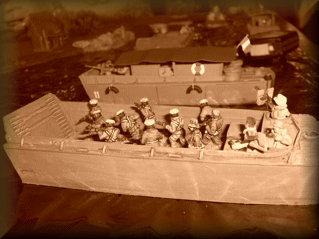 Song Day, or the Day
River is the southern arm of the Tonkin Delta, where the Red, Black and
Clear Rivers flow to the sea and create the fertile rice basket of North
Vietnam. For most of the
Indochina War the Day was also the boundary between the French controlled
Delta region and the Viet Minh controlled areas surrounding it.
For the French “controlled” is a cosmetic term as much of the Delta
was actually firmly under Viet Minh control.
Two Main Force Viet Minh regiments were permanently based there, and
other Main Force divisions could easily cross into the Delta.
One thing that prevented the Viet Minh from operating at will within
the Delta was French control of the rivers by groups of armoured assault
vessels, the famous “Dinassauts.”
Whilst large Viet Minh forces could cross any river, the dinassauts
offered the French High Command the means of moving troops and firepower
quickly to the threatened area to cut the Viet Minh supply lines.
This proved a decisive factor in the defeat of the Viet Minh at the
Battle of the Day River in June 1951. Song Day, or the Day
River is the southern arm of the Tonkin Delta, where the Red, Black and
Clear Rivers flow to the sea and create the fertile rice basket of North
Vietnam. For most of the
Indochina War the Day was also the boundary between the French controlled
Delta region and the Viet Minh controlled areas surrounding it.
For the French “controlled” is a cosmetic term as much of the Delta
was actually firmly under Viet Minh control.
Two Main Force Viet Minh regiments were permanently based there, and
other Main Force divisions could easily cross into the Delta.
One thing that prevented the Viet Minh from operating at will within
the Delta was French control of the rivers by groups of armoured assault
vessels, the famous “Dinassauts.”
Whilst large Viet Minh forces could cross any river, the dinassauts
offered the French High Command the means of moving troops and firepower
quickly to the threatened area to cut the Viet Minh supply lines.
This proved a decisive factor in the defeat of the Viet Minh at the
Battle of the Day River in June 1951.
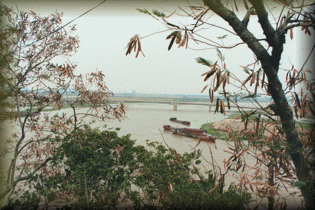 A dinassaut consisted
of World War II surplus landing craft of various sizes, often up-gunned and
up-armoured. In 1950 there were
two dinassauts in Tonkin but the concept proved so successful that by 1952
there were four, as well as “River Posts” of fewer, smaller boats at the
major towns. Early on, the average size of a dinassaut was about six boats
but later this increased too.
As well as having transport craft that could carry any unit, most dinassauts
also had their own intrinsic infantry in a “Light Accompanying Company”
(“CLA”), or they could embark one of the French Navy’s Marine Commandos. A dinassaut consisted
of World War II surplus landing craft of various sizes, often up-gunned and
up-armoured. In 1950 there were
two dinassauts in Tonkin but the concept proved so successful that by 1952
there were four, as well as “River Posts” of fewer, smaller boats at the
major towns. Early on, the average size of a dinassaut was about six boats
but later this increased too.
As well as having transport craft that could carry any unit, most dinassauts
also had their own intrinsic infantry in a “Light Accompanying Company”
(“CLA”), or they could embark one of the French Navy’s Marine Commandos.
If the dinassauts are
one of the hardware reasons why the French Indochina War is such an
interesting period to study and wargame, the commandos are one of the
software reasons. Every French
service in Indochina had its commandos, Army, Navy, Airforce, Intelligence,
even the Gendarmerie. Normally
a commando was of about company strength, with fewer heavy weapons, but
often with a higher proportion of NCOs and automatic weapons, that gave them
flexible command and control and good firepower.
Most of the commandos were composed of Vietnamese other ranks and
NCOs, stiffened by French officers, NCOs and specialist other ranks.
However, the Marine Commandos were entirely French and retained this
status for much longer than the French army units that were “yellowed” by
adding local personnel under De Lattre’s programme to build up the Vietnamese
National Army. But it was from
the local units eventually attached to the Marine Commandos, and the CLAs,
that the formidable ARVN Marine Division of the Second Indochina War sourced
its early recruits and traced its heritage.
Of the multitude of
commandos formed I have two special favourites.
First the Marine Commando De Montfort is a must simply because of the
uniforms. They wore British
Royal Marine Commando green berets and British Paratroop “Denison” smocks.
In my imagination they looked at themselves in the mirror, smiled,
said “not bad eh?” but worried that something was still missing.
A light bulb went off in their heads and they realised that all that
they had to do to give themselves the most “bitchin’ ” combat appearance in
the entire theatre was to eschew the common-or-garden French MAT
sub-machineguns, or the gangster-like American Tommy guns, and instead adopt
the elegant menace of the German MP40 Schmeisser as their clothing accessory
of choice…voila!
On the other hand the
Commando 24 “Vandenberghe” didn’t have any uniforms but sported Viet Minh,
i.e. peasant, dress and Viet Minh helmets for their operations.
The unit’s commander, Roger Vandenberghe is the sort of character
that even Hollywood couldn’t invent.
Of Jewish stock he was 12 when the Second World War broke out.
His father died and his mother was deported and murdered in the Nazi
death camps. Roger and his
elder brother were declared orphans but ran away from their foster home to
join the Resistance, fighting the Germans in the Pyrenees.
With the Liberation Vandenberghe’s Resistance group was subsumed into
the regular French army and he went on to fight in Germany, earning his
first Croix de Guerre when he was 17.
In 1947 he was posted to Indochina where, with the exalted rank of
Corporal Chef, he found himself leading a platoon of local partisans.
This platoon became the reconnaissance element of the 6th
Infantry Regiment and later grew into the 11th Light Military
Supplementary Company (“CSLM”), before becoming Commando 24.
Vandenberghe himself rose to the rank of Adjutant-Chef or Warrant
Officer.
Commando 24 was
composed of volunteers from the Tho, Nung and Meo ethnic groups who were
traditionally hostile to the Viet Minh and also included many “turned” Viet
Minh, who, with no way back to their old allegiance, should have been
totally reliable. However this
practice also left the Commando open to infiltration by not-so-turned Viet
Minh agents, and on several occasions Vandenberghe had to deal expeditiously
with plots against him.
Commando 24 was one of the original 30 “Commandos de Zone” that covered the
Delta. It was probably a lot
more effective at guerrilla tactics than any line company, and it certainly
was a lot more “expendable” as far as the High Command was concerned.
So it often got the most dangerous missions, operating behind enemy
lines as mock Viet Minh.
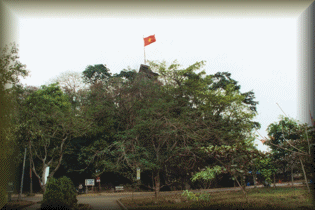 The high point of
Vandenberghe’s career came in May 1951 when the Commando had to cross the
Day and penetrate the lines of the Viet Minh assaulting the town of Ninh Bin
(where Marshal de Lattre de Tassigny’s only son Bernard lay dead on the
famous “rock” dominating the river), to reinforce the Vietnamese Army and
Marine Commando defenders until relieved by regular forces.
Commando 24 infiltrated the Viet Minh position, stormed the rock,
recovered de Lattre’s body, and held out until relieved – at the cost of
one-third casualties for the unit and another bad wound for its commander. The high point of
Vandenberghe’s career came in May 1951 when the Commando had to cross the
Day and penetrate the lines of the Viet Minh assaulting the town of Ninh Bin
(where Marshal de Lattre de Tassigny’s only son Bernard lay dead on the
famous “rock” dominating the river), to reinforce the Vietnamese Army and
Marine Commando defenders until relieved by regular forces.
Commando 24 infiltrated the Viet Minh position, stormed the rock,
recovered de Lattre’s body, and held out until relieved – at the cost of
one-third casualties for the unit and another bad wound for its commander.
Vandenberghe was
finally commissioned lieutenant after Ninh Bin.
In his service he earned the Legion of Honour, the Military Medal,
the Croix de Guerre for 1939 / 45, the Croix de Guerre for Indochina with 14
bars, six mentions in despatches and eight wound stripes.
Marshal de Lattre considered him one of the, if not the, best small
unit commanders in Vietnam and said, “give me 100 Vandenberghes and Vietnam
will be free”. Alas though,
soon there was not even one Vandenberghe.
The losses at Ninh Bin were replaced with more turned Viet Minh and
the inevitable infiltration finally succeeded:
Vandenberghe was assassinated in January 1952 and his Commando
destroyed from the inside.
For those of you who
think that my descriptions of the Commando De Montfort and the Commando
Vandenberghe are coloured by too much Vinogel or 33 Bier, click
here to see the official French army photo archives of the “Pirates of
the Delta”. OK…
I appreciate that the early photos of the Commando De Montfort
dressed to the nines are clearly of a staged exercise in the photogenic Ha
Long Bay, and that the actual combat shots show them much more nondescript
and scruffy, but which would you rather paint?
The Idea
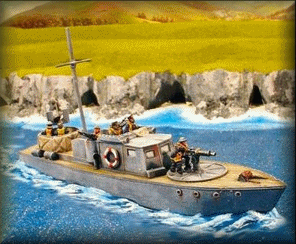 As I mentioned in my
“Why Indochina?” article a long time ago, one of the joys of this period
from the wargames point of view is sourcing and converting the esoteric
figures and kit. For instance,
out there in wargames land I discovered that SHQ Miniatures did British
Paras using captured German weapons, ideal for the Commando De Montfort with
their berets, smocks and Schmeissers.
Tim had converted a brace of Airfix / Heller LCVPs into their
distinctive Indochinese appearance.
I took a Britannia British Habour Defence Motor Launch with its pom
pom gun and bearded and duffle coated crew, and converted it into French
up-armoured and up-gunned Vedette du Port, with a more tropically relaxed
crew in bare buff and shorts from Raventhorpe and Britannia, commanded by an
Airfix RAF officer as the immaculate enseigne de vaisseau in his tropical
whites. The final bit of colour
was provided by Tim acquiring the new Liberation Miniatures Moroccans.
Having assembled all these toys all that was required was a scenario
that would use them and keep five gentlemen entertained for an afternoon. As I mentioned in my
“Why Indochina?” article a long time ago, one of the joys of this period
from the wargames point of view is sourcing and converting the esoteric
figures and kit. For instance,
out there in wargames land I discovered that SHQ Miniatures did British
Paras using captured German weapons, ideal for the Commando De Montfort with
their berets, smocks and Schmeissers.
Tim had converted a brace of Airfix / Heller LCVPs into their
distinctive Indochinese appearance.
I took a Britannia British Habour Defence Motor Launch with its pom
pom gun and bearded and duffle coated crew, and converted it into French
up-armoured and up-gunned Vedette du Port, with a more tropically relaxed
crew in bare buff and shorts from Raventhorpe and Britannia, commanded by an
Airfix RAF officer as the immaculate enseigne de vaisseau in his tropical
whites. The final bit of colour
was provided by Tim acquiring the new Liberation Miniatures Moroccans.
Having assembled all these toys all that was required was a scenario
that would use them and keep five gentlemen entertained for an afternoon.
The basic scenario
envisaged the Commando Vandenberghe attempting to infiltrate Viet Minh
positions to pass on a high value prisoner to a dinassaut transported
landing force consisting of the Commando De Montfort and a Company of
Moroccan tiralleurs. The game
was to take place on a fictional, but typical, part of the Day, Ban Doa Quoc
or “Patriots’ Point”. The river
defences were based on those shown in “La Marine Français Dans La Guerre
d’Indochine” by Contre-amiral Bernard Estival, and included controlled mines
and prepared positions.
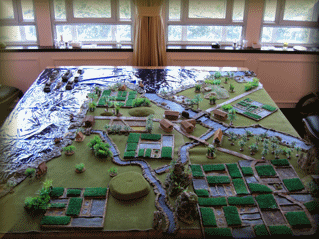 As you can see from the
orders the problem for
the Commando Vandenberghe and the dinassaut was that they did not know where
each other would be. The
problem for the Viet Minh was that they did not know what was going on.
The problem for everyone was that all this was all going to happen at
night. I did not tell the
players their victory conditions although, in broad terms, they were pretty
obvious to each, but the game was designed so that everyone could win.
For the Viet Minh and the dinassaut forces it would depend on
recovery of the prisoner, and their own loss to enemy kill ratio.
For the Commando Vandenberghe it would depend upon whether they could
pass on the prisoner safely and in how much secrecy they could do this.
With the participants pondering the uncertainties of their positions
Jeff took on the role of Comrade Je’s turncoat cousin leading the
Vandenberghe, Tim, represented the Bonenfant family’s naval arm commanding
the De Montfort, Neil “Ben Ned” stepped out as the Moroccan Captain and
Andrzej and Franky dug in as the hardened Viet Minh Regional Company
Commanders Hahn Che and Li. As you can see from the
orders the problem for
the Commando Vandenberghe and the dinassaut was that they did not know where
each other would be. The
problem for the Viet Minh was that they did not know what was going on.
The problem for everyone was that all this was all going to happen at
night. I did not tell the
players their victory conditions although, in broad terms, they were pretty
obvious to each, but the game was designed so that everyone could win.
For the Viet Minh and the dinassaut forces it would depend on
recovery of the prisoner, and their own loss to enemy kill ratio.
For the Commando Vandenberghe it would depend upon whether they could
pass on the prisoner safely and in how much secrecy they could do this.
With the participants pondering the uncertainties of their positions
Jeff took on the role of Comrade Je’s turncoat cousin leading the
Vandenberghe, Tim, represented the Bonenfant family’s naval arm commanding
the De Montfort, Neil “Ben Ned” stepped out as the Moroccan Captain and
Andrzej and Franky dug in as the hardened Viet Minh Regional Company
Commanders Hahn Che and Li.
The Plans
The dinassaut and
Vandenberghers chose diametrically opposed strategies.
Tim decided to move as far as possible into the Viet Minh position
and chose his landing site as close to the expected entry point of the
Vandenberghe as he could. This
entailed a long journey along the river which, if conducted slowly and
relatively quietly, should be safe from detection until the final approach.
The downside of this was that, at some point, an equally long
withdrawl along the river would be necessary with the Viet Minh fully alert
this time.
Jeff decided that the
Vandenberghers would move as little as possible.
Securing a perimeter with two platoons the third platoon held the
prisoner safely in the rear and the Commando hunkered down to await
developments. Thus, as it
turned out, the two plans complimented each other well.
Because Jeff didn’t move far from his entry point, and because Tim
tried to land as close as possible to that entry point, both were well
placed to link up. The only
problem being the time used up by the long dinassaut approach.
For their part the Viet
Minh opted for defence in depth.
Patriots’ Point was split diagonally between the two Regional
Companies. Appreciating that
the French would have a lot of firepower on the river both commanders only
put one platoon forward in well dug in positions, supported by recoilless
rifles to take on the landing craft, and screened by the village militia.
The other platoons and heavy weapons were echeloned back throughout
the position where they could take on any French attackers after they had
gone beyond the support of the dinassaut.
The Game Mechanics
As usual we used
“Crossfire” Rules with my “Contre Les Viets” amendments.
Visibility was 12”.
Company commanders had a few Verey flares each which would illuminate their
own position to a radius of 24” for their own impulse only.
Mortar parachute flares could be fired as directed and would
illuminate the target to a radius of 24” for the firer’s impulse and the
opponent’s impulse.
The Viet Minh mines,
fighting positions and bunkers; and their troop dispositions were marked on
maps so we didn’t have to use the usual dummy counters.
When a Viet Minh or Vandenbergher ordered a move I, as umpire, would
calculate how long it would take and also throw for bogging where necessary.
This system worked remarkably smoothly.
Finally, to simulate
the unreliable dispositions and morale of the village militia, the Viet Minh
players were given civilian figures to deploy.
These would not move until enemy units came in sight and would then
dice. On a score of 1, 2 or 3
there was nothing there; 4 would get you one militiaman; 5 two; and 6 a
squad of three. A full size
squad would operate as a normal Crossfire squad, being able to move when in
command, and able to fire with the normal three dice.
The groups of one or two militiamen would fire with one or two dice
respectively and could only move towards other militiamen; i.e. the had
either to stay put and fight or regroup into proper tactical units.
If a sub-squad group suffered any combat result, including pinned or
suppressed, it was killed – there would be insufficient leadership to hold
them together and they would either permanently go to ground or disperse.
I was pleased with the way that this little rule worked.
Neither side could be sure what was what, and, although the Viet Minh
could ensure some coverage of an area by putting several civilian figures
there, they could not be certain how effective the resulting militia would
be.
The Night
At 0015 hours a platoon
of weary and muddy Viet Minh Regionals traipsed into the most north-easterly
hamlet of the many in Ban Doa Quoc.
They exchanged fraternal greetings with some of Comrade LI’s men and
explained that 42nd Regiment had given instructions for them to
reinforce the river line. LI’s
men bade them well and the Vandenberghers, for it was they, traipsed out of
the hamlet to take up positions in the paddy beyond.
As they did so the second platoon of Commando 24 that had been
covering the move from the jungle bordering the hamlet relaxed their trigger
fingers … Having secured a
perimeter that would allow them to move in any direction when the arrival of
the dinassault was known, the Vandenberghers settled down to wait, with the
croaking of the frogs and the bites of the mosquitoes to keep them awake
through what could be a long night.
On board the dinassault
boats, their engines ticking over to give them barely steerageway against
the current of the Day River the long, but relatively silent approach was
wearing on the nerves of the Moroccans and Marines.
Anything could give them away, a backfire from the worn out diesels
of the landing craft, an ill-guarded cigarette, let alone an alert Viet Minh
on the dark banks beyond. But
Bonenfant had put his faith in a covert approach and his faith was upheld …
almost.
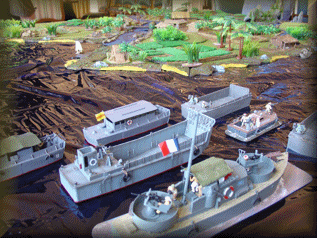 At 0215 hrs the
dinassaut turned 90 degrees from its approach in column into its line
assault formation. The right
flank was covered by a “Y” cutter vedette du patrol.
Then came two pairs of landing craft containing first the De
Montfort, then the Moroccans.
The left flank was covered by the powerfully armed vedette du port.
Behind the assault forces the larger LCM du Train waited off shore
until it was needed. As they
approached the shore details emerged from the darkness and the gunners
behind their Oerlikons and .50 calibers took aim on anything suspicious.
On the right the gunners held their fire but on the left the cannon
and machine guns spat out at the sampans moored on the river bank, leaving
them burning and sinking as the landing craft touched bottom and the ramps
splashed down onto the muddy banks of the Day. At 0215 hrs the
dinassaut turned 90 degrees from its approach in column into its line
assault formation. The right
flank was covered by a “Y” cutter vedette du patrol.
Then came two pairs of landing craft containing first the De
Montfort, then the Moroccans.
The left flank was covered by the powerfully armed vedette du port.
Behind the assault forces the larger LCM du Train waited off shore
until it was needed. As they
approached the shore details emerged from the darkness and the gunners
behind their Oerlikons and .50 calibers took aim on anything suspicious.
On the right the gunners held their fire but on the left the cannon
and machine guns spat out at the sampans moored on the river bank, leaving
them burning and sinking as the landing craft touched bottom and the ramps
splashed down onto the muddy banks of the Day.
Almost at once things
started to go wrong.
Bonenfant’s plan had envisaged the entire dinassaut arriving in one compact
mass. During the long approach
however the vedette du port had not kept station so, when the formation
turned into the banks, she was further down river than she should have been.
This bad navigation would not have mattered except that Bonefant’s
approach had fortuitously kept the dinassaut clear of the Viet Minh mines in
the river, but the vedette du port’s lapse took her almost directly on top
of a controlled mine.
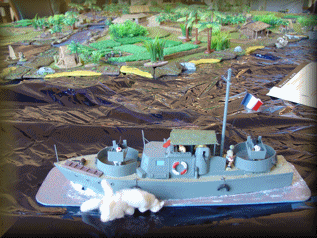 On the river bank
Platoon Leader Dinh of Li’s first platoon held his breath, flicked the
switch that connected the batteries to the mine’s detonator, and prayed that
the thousand-and-one things that could go wrong with a improvised electrical
device under water did not go wrong.
His prayer was rewarded by a tower of water erupting just yards from
the vedette’s port side. Dinh
stared, not believing that the mine had worked.
Then he recovered himself; put all reactionary superstitious thoughts
of prayer out of his mind; and regaled his cheering men with a short
discourse on the triumph of the Patriot Masses’ Socialist engineering skills
over the capitalist hand-me-downs that the imperialist British had given to
their country’s French oppressors. On the river bank
Platoon Leader Dinh of Li’s first platoon held his breath, flicked the
switch that connected the batteries to the mine’s detonator, and prayed that
the thousand-and-one things that could go wrong with a improvised electrical
device under water did not go wrong.
His prayer was rewarded by a tower of water erupting just yards from
the vedette’s port side. Dinh
stared, not believing that the mine had worked.
Then he recovered himself; put all reactionary superstitious thoughts
of prayer out of his mind; and regaled his cheering men with a short
discourse on the triumph of the Patriot Masses’ Socialist engineering skills
over the capitalist hand-me-downs that the imperialist British had given to
their country’s French oppressors.
To the Moroccans
peering over the bulwarks of the landing craft the crippling of their
largest escort was not a good omen for their own prospects, and this omen
proved true. As the platoons
splashed ashore they came under heavy fire from Dinh’s men and were pinned
down on the riverbank. To their
right the Commando De Montfort got ashore in good order, seeing off a few
militiamen, but as they pushed inland a rattle of small arms from another of
Li’s squads halted them and this was followed by the boom of an SKZ
recoilless rifle shattering the night.
It was with mixed feelings that the Marine Commandos realised that
the SKZ was not firing at them but at the ‘Y’ cutter in the river behind
them, as a series of direct hits crippled the smaller vedette.
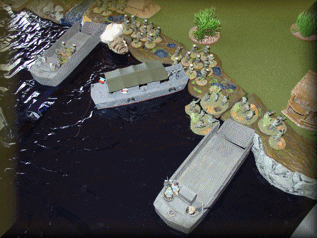 The Commando De
Montfort reacted quickly to this threatening situation.
The Viet Minh platoon in front of them was actually split between two
positions, one squad and the SKZ to the front, and the other two squads
further to the rear. With the
heavy weapons on the landing craft supporting them the Marines made good use
of fire and movement, suppressing and then close assaulting the two Viet
Minh positions in quick succession.
They were now in a position to push inland and find the Vandenberghe. The Commando De
Montfort reacted quickly to this threatening situation.
The Viet Minh platoon in front of them was actually split between two
positions, one squad and the SKZ to the front, and the other two squads
further to the rear. With the
heavy weapons on the landing craft supporting them the Marines made good use
of fire and movement, suppressing and then close assaulting the two Viet
Minh positions in quick succession.
They were now in a position to push inland and find the Vandenberghe.
The gunfire and
explosions from the riverbank left Je in no doubt where the dinassaut had
arrived and he quickly took his third platoon, with the prisoner, to
reinforce the platoon in the paddy.
They then moved forward into some calcaieres and from these limestone
crags they could look down to the banks of the Day.
Although in the darkness they could not make out fried or foe, the
tracer, flares and fires on the river bank and the vessels beyond showed the
positions of the combatants as clear as any map.
The calcaieres were an ideal position for Je but there was just one
snag … they were also occupied by Li’s last platoon.
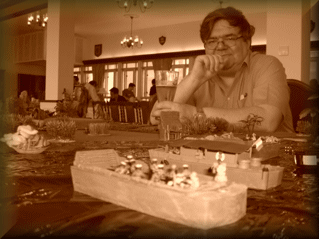 The De Montfort too
could see the calcaieres, silhouetted against the night sky, and they
splashed forward through some paddies towards them.
As they did so they exposed their flank to a squad of militia and the
Commando’s headquarters was pinned down.
Bonenfant brought up one of his platoons to bring fire down on the
militia to relieve the HQ, whilst the rest of the Commando pushed on towards
the calcaieres. As they emerged
from the paddy they found before them an open field and a stream with the
calcaieres beyond. Suddenly a
torch flashed in the darkness:
“…-”. The Marines understood
what the ‘V’ sign meant but still they were not prepared for the
concentrated fire of three platoons pouring out of the calcaieres.
They were even less prepared to discover that, whilst two of those
platoons were shooting high and wide, one was shooting in deadly earnest.
The lead squad of Marines took heavy casualties and the others had
great difficulty in extricating themselves, falling back into the darkness
of the paddy. Out of sight of
the calcaieres, where Bonenfant had regrouped and the flanking fire from the
militia was very much the lesser of two evils. The De Montfort too
could see the calcaieres, silhouetted against the night sky, and they
splashed forward through some paddies towards them.
As they did so they exposed their flank to a squad of militia and the
Commando’s headquarters was pinned down.
Bonenfant brought up one of his platoons to bring fire down on the
militia to relieve the HQ, whilst the rest of the Commando pushed on towards
the calcaieres. As they emerged
from the paddy they found before them an open field and a stream with the
calcaieres beyond. Suddenly a
torch flashed in the darkness:
“…-”. The Marines understood
what the ‘V’ sign meant but still they were not prepared for the
concentrated fire of three platoons pouring out of the calcaieres.
They were even less prepared to discover that, whilst two of those
platoons were shooting high and wide, one was shooting in deadly earnest.
The lead squad of Marines took heavy casualties and the others had
great difficulty in extricating themselves, falling back into the darkness
of the paddy. Out of sight of
the calcaieres, where Bonenfant had regrouped and the flanking fire from the
militia was very much the lesser of two evils.
Je conferred quickly
with his second platoon commander and then led his third platoon forward,
splashing across the stream towards the paddy in the darkness beyond.
Minutes later Li’s men in the calcaieres and the militiamen saw the
centre of the paddy erupt in tracer and grenade explosions.
Then there was silence . . .
Back at the beachhead
fire from the crippled vedette du port as it floated downstream, and from
the landing craft was slowly wearing down Dinh’s platoon and bringing some
relief to the Moroccans pinned down on the riverbank.
This was short-lived however as mortor rounds started to fall amongst
the hapless North Africans.
Comrade Li had brought his Headquarters element forward.
He had sited a heavy machine gun just at the edge of darkness in
front of the Moroccan position so that if they moved forward they would be
enfiladed, and he was now carefully adjusting the mortar fire by virtue of
Verey flares sent up by Dinh.
In doing so Dinh was signing his own death warrant as the return fire
finally put an end to him and his platoon.
And what of Hahn Che?
His company had held the Western part of Ban Doa Quoc with his heavy
weapons and Militia covering the riverbanks, and with his Regional platoons
echeloned back in jungle and hamlets on a line dividing Ban Doa Quoc in two.
Thus his men were well placed either to counter attack or to take any
forward move by the Moroccans in the flank.
Once the location of the French landing was clear Hahn Che redeployed
his heavy weapons to reinforce the infantry line and by 0300 hrs his whole
company was in place. Having
done so Hahn Che moved forward himself to direct the fire of his own mortar,
cleverly moving right up to Dinh’s old position which had been thoroughly
raked over by French fire and was now being ignored by them.
To command North
African’s well it was necessary to have good “baraka” – an aura of luck and
authority. Ben Ned now
demonstrated that his baraka was in fine shape.
Ignoring the mortar rounds he moved amongst his squads on the
riverbank and rallied them. Ben
Ned’s instructions had been to push inland to cover the flank of the Marines
and now he was at last able to do so.
But, just as he was shaking his platoons into line for an advance,
which unbeknownst to him would take him straight into Li and Hahn Che’s
killing zone, he was stopped by a crackling of radios and a blowing of
whistles to his right – the Marines were falling back to their landing
craft, it was time to pull out.
The evacuation could
have been handled better. The
De Montfort embarked safely but in their haste non-one considered the
battered ‘Y’ cutter, which was left behind in the darkness its crew making
frantic repairs. A few minutes
taken out to rig a towline would have saved many sailors’ lives.
The Moroccans were also caught by the haste of the withdrawal and as
a result one of their landing craft was badly overloaded whilst the other
carried only a couple of squads.
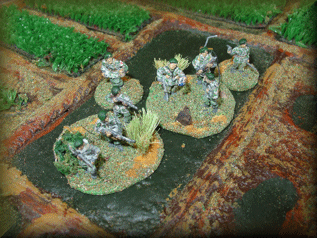 The French had good
cause to hurry as the lightening of the eastern sky told them that the cover
of night on the Day was running out.
Seeing the French depart the Viet Minh redoubled their efforts,
concentrating both mortars on the Moroccan’s landing craft.
Inevitably some of the rounds hit home and in the packed confines of
the open topped armoured boxes the results of direct hits were devastating.
Hahn Che redeployed his heavy weapons to the river bank and as dawn
came the dinassaut had to run the gauntlet they had avoided on their
approach. Sailing in a compact
group the landing craft were battered, but putting down heavy return fire,
were mostly unscathed. The ‘Y’
cutter, following behind and alone, in broad daylight now, was left a
floating wreck with its entire crew killed or injured and only the strong
current of Song Day carrying it to safety. The French had good
cause to hurry as the lightening of the eastern sky told them that the cover
of night on the Day was running out.
Seeing the French depart the Viet Minh redoubled their efforts,
concentrating both mortars on the Moroccan’s landing craft.
Inevitably some of the rounds hit home and in the packed confines of
the open topped armoured boxes the results of direct hits were devastating.
Hahn Che redeployed his heavy weapons to the river bank and as dawn
came the dinassaut had to run the gauntlet they had avoided on their
approach. Sailing in a compact
group the landing craft were battered, but putting down heavy return fire,
were mostly unscathed. The ‘Y’
cutter, following behind and alone, in broad daylight now, was left a
floating wreck with its entire crew killed or injured and only the strong
current of Song Day carrying it to safety.
With the guns silent
Comrade Li surveyed the field.
He found the dead hero Dinh, still clutching his Verey pistol, his satchel
of flares empty, surrounded by the survivors of his platoon.
Then Li inspected the remains of his second platoon, overrun by the
French. He congratulated the
militia squad that had halted the Marines’ progress through the paddy.
Li assured them of their impending elevation to Regional status.
He put down their less than enthusiastic response to this honour to
fatigue; it had been a long night after all.
Then he climbed into the calcaieres to find his third platoon.
The militia had told him of the firefights before the calcaieres and
in the paddy so he expected his men to be relatively unscathed.
Aghast Li found them all dead or missing.
He looked at the bodies, some shot at close range, some shot in the
back, some victim to knife wounds.
Now Li understood. As he
looked out over the scarred paddy and smoldering hamlets to the brown river
beyond he knew that there had been treachery this night on the Day.
Postscript
Extract from the Report
of Je O Wen to Adjutant Chef Vandenberghe, Commando 24 Nord Viet Nam:
“… Realising that
the Commando de Montfort could not advance into the fire of the rebel
platoon holding the calcaieres I staged a mock advance with my third platoon
in order to mask the rebel’s fire.
Before doing so I instructed the second platoon to remain in
the calcaieres and to destroy the rebel platoon as discretely as possible to
secure my own line of retreat.
Having entered the
paddy I made the recognition signal and was answered by Captain de Corvette
Bonenfant. We
passed on the prisoner under cover of a mock firefight.
Commando De Montfort commenced their withdrawal to the river
and I then withdrew to the calcaieres where I found that 2nd
Platoon had dealt with the rebels most expeditiously and effectively.
I then gave the order to withdraw in platoon order 3, 2, 1
and the entire Commando had safely broken contact with the enemy by 0445
hrs. The
Commando suffered no killed and only five wounded from 2nd
Platoon during the fight on the calcaieres.”
back
to vietnam
|